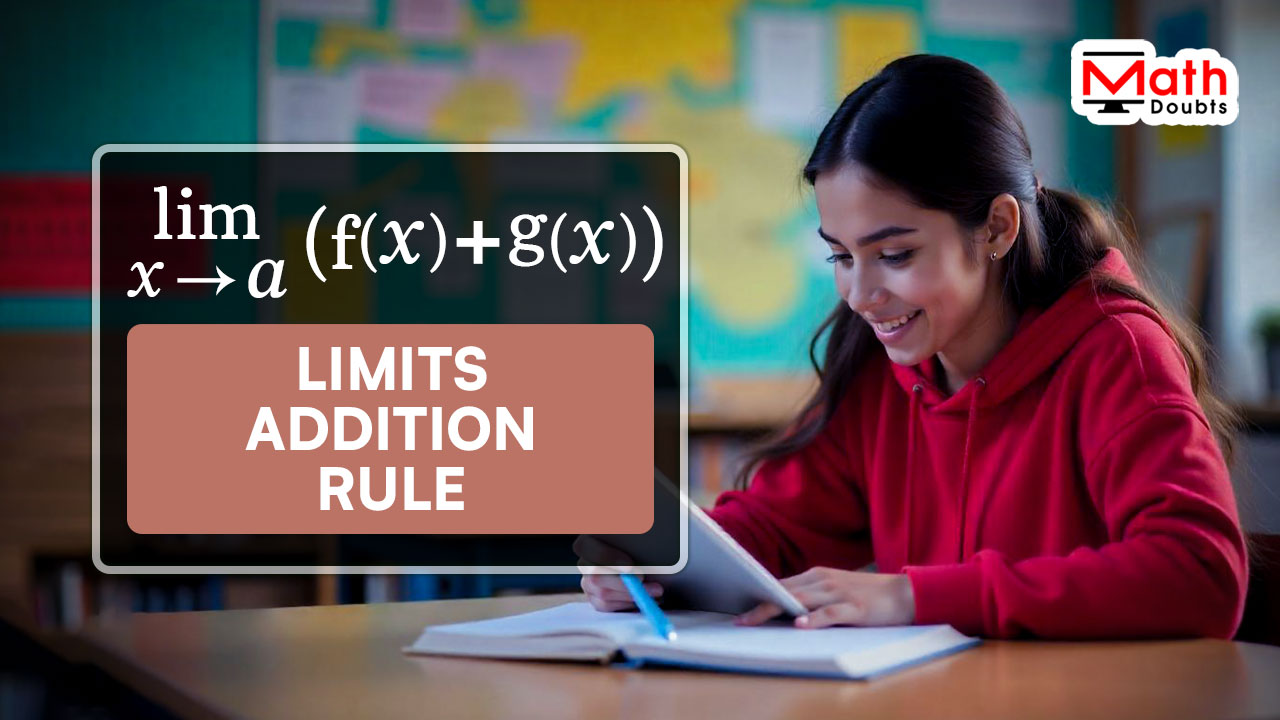$\displaystyle \large \lim_{x \,\to\, a}{\normalsize \big[f{(x)}+g{(x)}\big]}$ $\,=\,$ $\displaystyle \large \lim_{x \,\to\, a}{\normalsize f{(x)}}$ $+$ $\displaystyle \large \lim_{x \,\to\, a}{\normalsize g{(x)}}$
An expression can be formed by the addition of two or more functions in mathematics. The sum of functions may interrupt the process of finding the limit. So, a limit formula is required to find the limit of sum of functions and it is called the addition of limits rule. It is also called the sum of limits rule.

Let’s express two functions as $f(x)$ and $g(x)$ and their sum is written as $f(x)+g(x)$ in mathematics. The limit of this expression as the value of variable $x$ approaches a value $a$ is written as follows.
$\displaystyle \large \lim_{x \,\to\, a}{\normalsize \big[f{(x)}+g{(x)}\big]}$
According to sum law of limits in calculus, the limit of a sum is equal to sum of their limits. So, the limit of sum of functions $f(x)$ and $g(x)$ is equal to sum of the limits of $f(x)$ and $g(x)$ as $x$ tends to $a$.
$\displaystyle \large \lim_{x \,\to\, a} \normalsize \Big(f{(x)}+g{(x)}\Big)$ $\,=\,$ $\displaystyle \large \lim_{x \,\to\, a}{\normalsize f{(x)}}$ $+$ $\displaystyle \large \lim_{x \,\to\, a}{\normalsize g{(x)}}$
It is a mathematical expression of the sum of limits theorem and it is used as a formula in calculus.
Let’s understand the limit sum rule from an easy limit problem.
Evaluate $\displaystyle \large \lim_{x \,\to\, 2}{\normalsize (x^2+3x)}$
Use the direct substitution method to find the limit of sum of functions.
$\implies$ $\displaystyle \large \lim_{x \,\to\, 2}{\normalsize (x^2+3x)}$ $\,=\,$ $2^2+3(2)$
$\,\,=\,$ $2 \times 2+3 \times 2$
$\,\,=\,$ $4+6$
$\,\,=\,$ $10$
Now, let’s find the limit of each function in the expression.
$(1).\,\,$ $\displaystyle \large \lim_{x \,\to\, 2}{\normalsize x^2}$ $\,=\,$ $2^2$ $\,=\,$ $4$
$(2).\,\,$ $\displaystyle \large \lim_{x \,\to\, 2}{\normalsize 3x}$ $\,=\,$ $3(2)$ $\,=\,$ $6$
Add the limits of both functions to find their sum.
$\implies$ $\displaystyle \large \lim_{x \,\to\, 2}{\normalsize x^2}$ $+$ $\displaystyle \large \lim_{x \,\to\, 2}{\normalsize 3x}$ $\,=\,$ $4+6$ $\,=\,$ $10$
It is proved that the limit of sum of the functions is equal to the sum of their limits.
$\,\,\,\,\,\,\therefore\,\,\,$ $\displaystyle \large \lim_{x \,\to\, 2}{\normalsize (x^2+3x)}$ $\,=\,$ $\displaystyle \large \lim_{x \,\to\, 2}{\normalsize x^2}$ $+$ $\displaystyle \large \lim_{x \,\to\, 2}{\normalsize 3x}$ $\,=\,$ $4+6$ $\,=\,$ $10$
Now, let’s learn more about the limit of a sum law.
The addition rule for limits is not limited to two functions and it can be extended to more than two functions. So, the limit of sum rule can be written as follows.
$\displaystyle \large \lim_{x \,\to\, a} \normalsize \Big[f_{1}{(x)}+f_{2}{(x)}+f_{3}{(x)}+\cdots\Big]$ $\,=\,$ $\displaystyle \large \lim_{x \,\to\, a}{\normalsize f_{1}{(x)}}$ $+$ $\displaystyle \large \lim_{x \,\to\, a}{\normalsize f_{2}{(x)}}$ $+$ $\displaystyle \large \lim_{x \,\to\, a}{\normalsize f_{3}{(x)}}$ $+$ $\cdots$
The limit of sum formula’s proof to learn how to prove the limit of sum of functions is equal to sum of their limits.
A free math education service for students to learn every math concept easily, for teachers to teach mathematics understandably and for mathematicians to share their maths researching projects.
Copyright © 2012 - 2025 Math Doubts, All Rights Reserved